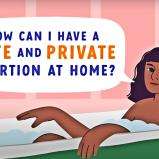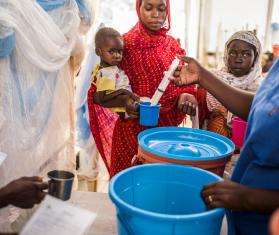Originally published on September 23, 2021
People who cannot access safe care due to legal restrictions, cost, stigma, or a lack of accurate information will often resort to unsafe methods to end an unwanted pregnancy. Unsafe abortion is a leading cause of maternal mortality around the world, resulting in an estimated 29,000 maternal deaths per year. Millions of people who survive unsafe abortions will suffer from severe complications.
Doctors Without Borders/Médecins Sans Frontières (MSF) considers access to safe abortion care a critical part of comprehensive reproductive health care, one that reduces maternal mortality and suffering. We are committed to providing safe abortion care to reduce avoidable suffering and deaths. In 2023, MSF teams around the world provided 54,500 consultations for safe abortion care, the majority in African countries, along with 31,000 consultations for post-abortion care, most taking place in Afghanistan, Yemen, South Sudan, and Bangladesh. Learn more about abortion and how MSF works to ensure safe abortion care in the frequently asked questions below.*
*Disclaimer: Everyone is different, and if you have specific questions related to your health you should see a qualified health care provider.
What is abortion and how common is it?
Abortion occurs when a pregnancy is ended. It can happen spontaneously, also referred to as miscarriage, or as the result of a deliberate intervention. Abortion is very common: 3 out of every 10 pregnancies worldwide end in abortion. Chances are, someone close to you has had an abortion.
What is safe abortion care?
An abortion is considered safe if the person providing or supporting the abortion is trained and an evidence-based method that is appropriate to the pregnancy duration is used. Medication abortion, or an abortion with pills, is an example of a safe, evidence-based method of abortion.
What are the barriers to accessing safe abortion care?
Beyond legal barriers, many people experience shame, social stigma, and negative attitudes about the circumstances that led to their unwanted pregnancy, or to the abortion itself—which in turn can create obstacles to accessing care. Common obstacles include verbal abuse or social rejection from family and friends, misrepresentation, or lack of information about laws regarding abortion, and rejection, stigma, and ignorance within the health system.
Why is access to safe abortion important?
Those who cannot access safe care due to legal restrictions, cost, stigma, or a lack of accurate information will often resort to unsafe methods to end an unwanted pregnancy. Unsafe abortion is a leading cause of maternal mortality around the world, causing an estimated 29,000 maternal deaths per year. Millions of people who survive unsafe abortions will suffer from severe complications.
What is an abortion with pills?
In an abortion with pills, a person takes medicines that cause cramping and bleeding to empty the uterus—similar to having a miscarriage. An abortion with pills is over 95 percent effective and is extremely safe, with less than a one percent chance of severe, life-threatening complications. The risk of death from a safe abortion is lower than from a shot of penicillin or from a tooth extraction.
What do I need to have a safe abortion with pills?
This video is intended solely for education and is not intended as a substitute for qualified medical services and advice. You should not rely solely on these materials, and they are provided “as is” and without any warranty, express or implied.
An abortion with pills can safely be provided in low-resource settings—including those without ultrasound or laboratory testing available. A safe abortion with pills needs only three things: accurate information, quality medications, and mutual respect and trust. Because of this, medication abortion has expanded access to safe abortion care for millions of people around the world—especially in conflict and crisis settings.
What is self-managed abortion?
Self-managed abortion with pills means obtaining and taking abortion pills outside of a medical setting. It most commonly refers to taking abortion medications at home with help from telephone hotlines or online platforms. Self-managed abortion increases access to safe abortion care for vulnerable people and those who live far away from healthcare facilities. It also upholds people’s autonomy and supports them to make decisions about and take the lead in their own care.
What does it feel like to have an abortion with pills?
This video is intended solely for education and is not intended as a substitute for qualified medical services and advice. You should not rely solely on these materials, and they are provided “as is” and without any warranty, express or implied.
Self-managed abortions can occur in all settings, including where abortion is legal and accessible, and may be a preferred option due to increased autonomy, privacy, and confidentiality, among other reasons. It also makes safe abortion care more accessible to people who live far from health facilities, or in areas that do not have abortion providers.
Are self-managed abortions safe?
A self-managed abortion can be just as safe and effective as the more traditional, facility-based approach. Therefore, in recent years, self-management of abortion with pills has gained increased acceptance by the formal health sector as safe and appropriate.

How to have a safe self-managed abortion
Learn moreSelf-managed abortions are safe if the person has access to accurate information, quality medications, and respectful support throughout the process, if desired. It’s also important to have access to a health care provider or facility on the rare chance there are complications. There is increasing evidence that in-person consultations and medical tests are not necessary for a safe abortion with pills. Studies have been published in the International Journal of Obstetrics and Gynaecology, JAMA Network, and ScienceDirect.
The best ways to make self-managed abortion safe are by ensuring access to quality medications and providing accurate information about how an abortion with pills works.
What is an unsafe abortion?
According to the World Health Organization, an abortion is unsafe if the person providing the abortion does not have the necessary skills or if the abortion takes place in an environment that does not meet minimal medical standards. Examples we see in our projects include: ingesting traditional remedies or toxic substances such as bleach, battery acid, or chlorine; incorrect administration of medications without the appropriate support; inflicting repeated blunt trauma to the abdomen; and inserting sharp sticks or needles into the body.
What are the medical consequences of unsafe abortion?
Complications from unsafe abortion include severe bleeding, infection, and injury to the genital tract or internal organs. Unsafe abortion can also lead to long-term health consequences such as infertility and chronic pain. An estimated 29,000 people die from the complications of unsafe abortion each year.
Who is most at risk of unsafe abortion?
Anyone with an unwanted pregnancy who cannot access safe abortion services is at risk of injury or death from unsafe abortion. Barriers to safe abortion include high cost, legal restrictions, stigma, lack of trained or willing providers, and unnecessary requirements.
Poor people, people of color, and people living in remote areas are disproportionately cut off from safe abortion services. The vast majority of unsafe abortions take place in low- and middle-income countries in Latin America, Africa, and Asia. People trapped in war, crisis, and conflicts often face additional barriers to accessing safe abortion care.
How can injuries and death from unsafe abortion be prevented?
Injuries and deaths resulting from unsafe abortions can be prevented by providing comprehensive reproductive health care programming, including sex education, contraceptive services, safe abortion care, and post-abortion care. Every safe abortion provided is potentially an unsafe abortion and maternal death prevented.
How MSF supports safe abortion care around the world
In order to reduce the maternal death and suffering from unwanted pregnancy and unsafe abortion, MSF offers a comprehensive package of reproductive health care services, including contraception, safe abortion care, and post-abortion care.
In an effort to make accurate information about safe abortion care more accessible and judgment-free and to counter harmful misinformation, MSF has partnered with Women First Digital (WFD) and its website HowToUseAbortionPill.org to produce a new series of simple, animated videos in 2023. MSF and WFD co-produced a previous public-facing series of short animated videos—How to ensure a safe abortion with pills—in 2021. These new videos address frequently asked questions about safe abortion care and are aimed at anyone who wants to understand what a safe abortion with pills entails, what the experience of a safe abortion is like, and how to talk about it in an open, supportive way.
How to talk about abortion
This video is intended solely for education and is not intended as a substitute for qualified medical services and advice. You should not rely solely on these materials, and they are provided “as is” and without any warranty, express or implied.
We also speak out publicly against harmful governmental policies like the Global Gag Rule, the overturning of Roe v. Wade by the US Supreme Court, and other efforts to limit access to care; and we share evidence-based, factual information about safe abortion care. Lastly, we conduct research investigating the severity and treatment of complications from unsafe abortion in conflict-affected settings.
Up to how far along in a pregnancy does MSF provide an abortion?
MSF guidelines include safe abortion care with pills through 22 weeks of pregnancy. We have provided care beyond 22 weeks on a case-by-case basis.
While abortions beyond 13 weeks of pregnancy (first trimester) compromise only 10-15 percent of the total abortions worldwide, they are responsible for the majority of serious complications and death from unsafe abortion. People who seek abortion beyond 13 weeks are more likely to be young girls, victims of sexual and gender-based violence, have detected their pregnancy later, or have financial or logistical barriers to care. Therefore, second trimester abortion services are a crucial element of safe abortion care and reproductive health care services, especially in humanitarian settings.
To help those seeking a self-managed abortion, MSF supports self-care interventions for sexual and reproductive health for a number of different topics, including self-testing for HIV and cervical cancer, self-administration of contraceptives, and self-managed abortion. In terms of self-managed abortion with pills, some MSF teams have worked with community health workers and peer educators to ensure people living in remote areas can access safe abortion care in their communities without having to travel to a health care facility. We are also piloting a telehealth hotline where MSF staff provide information and support for abortion over the phone.
What does MSF do in countries where abortion is illegal?
Many people think that abortion is either “legal” or “illegal” in a country, but the reality is not so black and white. Legal frameworks around abortion are complex and nuanced. In any country there might be multiple national statues, criminal codes, legal regulations, court decisions, ministerial guidelines, international treaties, and more. MSF does its best to navigate these complicated legal frameworks while prioritizing patients and their medical needs.
In the majority of countries where MSF works, abortion is permitted to save the life or preserve the health of a pregnant person. From a health perspective, a pregnant person's life and health is in danger anytime they have an unwanted pregnancy and do not have access to safe abortion care, as they would then be at risk of all the complications of unsafe abortion, including death.




